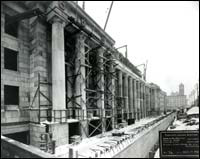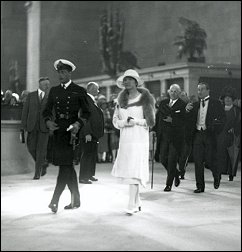
Construction on this iconic landmark began in 1914 amidst a materials shortage during World War I, but the station didn’t officially open until 1927. Since then, Union Station has welcomed waves of immigrants to Toronto, survived a major fire, and endured more than 90 years of wear and tear.
In 1975, Parks Canada designated Union Station a National Historic Site because it was, and still is, the country’s finest example of a classical beaux-arts railway station. Union Station is the largest of the great urban train stations built during the early 20th century.
Since acquiring Union Station in 2000, the City continues to own, manage and improve the station and is currently leading a multi-year revitalization that will make Union Station, one of Toronto’s crown jewels, spectacular again.

Union Station was designed in the grand manner of the École des Beaux-Arts in Paris by a team of architects composed of the Montreal firm of G.A. Ross and R.H. MacDonald, Hugh Jones of the CPR and John M. Lyle of Toronto. It was built by Canadian Pacific Railway and Grand Trunk Railway at a time when a railway station was viewed as the gateway to a city, Union Station was the largest and most opulent train station erected in Canada during the last great phase in railway station construction. Construction began in 1913 but was delayed for several years because of the First World War.
The shape of the ceiling is echoed in the four-storey, barrel-vaulted windows on the east and west walls. Mid-way up the north and south walls are carved the names of the cities that were then serviced by the CPR and the Canadian National Railways (CNR), the government-owned railway that replaced the Grand Trunk. The list alternates from side to side, naming the cities from east to west.
The interior walls are of Zumbro stone from Missouri; the floors are Tennessee marble, laid in a herringbone pattern. The exterior walls of the station are Indiana and Queenston limestone. Each of the 22 Bedford limestone columns weighs 75 tons is 40 feet high.
You build your stations like we build our cathedrals.
Prince of Wales, 1927

In front of a large crowd on August 6, 1927, His Royal Highness, Edward, the Prince of Wales, cut the ribbon that opened Union Station with a pair of gold scissors. The Prince of Wales was accompanied by his brother and sister-in-law, the Duke and Duchess of York (shown in foreground of photo), British Prime Minister Stanley Baldwin and Mrs. Baldwin, and Canadian Prime Minister William Lyon Mackenzie King. The welcoming party included Ontario Lieutenant Governor William Donald Ross and Mrs. Ross, Ontario Premier G. Howard Ferguson and numerous other members of the Ontario and Canadian governments.
After cutting the ribbon, the Prince of Wales was escorted to the ticket counters where he was issued the first ticket ever sold at Union Station. The ticket was to Alberta and cost $71.20 which today would be approximately $1184.49. During this 11-minute ceremony, the Prince of Wales was also presented with a gold key that unlocked the station. Later that week, on August 11, the Station received and dispatched its first passenger trains.

Before the current structure, an earlier Union Station was built in 1872 on Front Street between York and Simcoe Streets. The front of the old station was completed in 1895 and contained ticket offices, waiting rooms and railway offices. It was designed by E. P. Hannaford, Chief Engineer of the Grand Trunk Railway. The station was modelled on the Illinois Central Station in Chicago and had three domed towers, one containing a clock. In its time, the previous Union Station was considered to be one of the most modern and handsome stations on the continent. Its tall silhouette was a noted feature of the turn-of-the-century Toronto skyline.
Even though this station almost doubled the previous station in size, demands for an even larger station came soon after the completion. By 1911, the station handled some 40,000 passengers on more than 130 trains daily. The trainsheds were demolished in 1927 and 1928, and the station was torn down in 1931, four years after the present facility was officially opened.
Since the 1970s, Union Station has been set to countless films and TV movies, including: